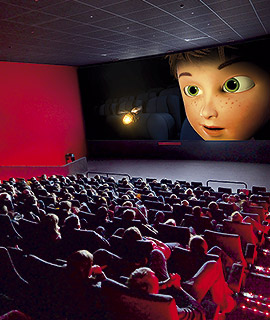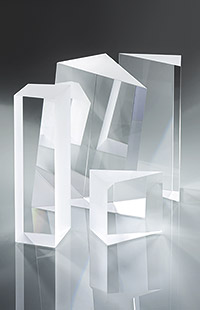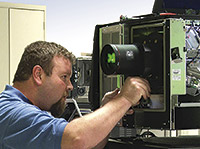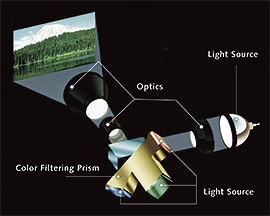“In 3-D presentations, two slightly different images are supplied from different camera perspectives – one for each eye,” explains Tim Sinnaeve, Market Director Digital Cinema at Barco N.V. This Belgian technology firm is one of the world’s leading companies in the area of professional visualization products. “The images are usually projected onto the screen on an alternating basis at a speed of 144 hertz. This is faster than the eye can perceive. The glasses that need to be worn while watching a 3-D movie filter the images in such a way that only the appropriate perspective reaches the left or right retina and thus creates the impression that this area is real inside the brain.” he adds.
For larger audiences, there is currently no alternative to these filter glasses. Without them, the movie would look blurred and out of focus. When several hundred people sit next to or behind each other to watch a movie, the images are transmitted separately to the left and right eye according to color, polarization or time and then selected for the respective eye by the eyeglasses. While filter glasses no longer need to be worn today with home cinema and office applications, these small systems do not come close to achieving the brilliant color experience shown on the big screen. “Digital high-end projectors for big screens display pin sharp images on a surface more than 200 square meters in size. The lamps with up to 7 kW of power produce a flow of light in excess of 40,000 lumens in 35 trillion colors. Even the smallest of details can thus be experienced,” Tim Sinnaeve explains. “These systems have been in constant use for decades. All of their components must be able to withstand high energy inside the smallest of spaces. The efficiency of the lens is extremely important here: each increase in light yield produces an even more intense image and lowers the operating costs for the owner,” he adds.
In order to meet these demanding requirements, Barco is using SCHOTT N-BK7® for color filter prisms that divide the white light of the lamp into the color components red, green, and blue (RGB) and direct it onto optical semiconductors using light guides made of the same material. The light has to travel through the material for distances of 150 mm and more, making SCHOTT’s materials key elements for the quality of the projector. Then, the so-called Digital Mirror Devices (DMD; see end of page) reflect the light onto the lens of the projector with the help of up to two million individually steerable micromirrors. This enables the movie to appear on the screen in front of the viewing audience incredibly clearly in 35 trillion colors. “SCHOTT N-BK7® is highly homogenous and offers high light yield. It is especially suited for lenses and prisms of cameras and projectors,” explains Ralf Reiter, Director Development and Applications at SCHOTT Advanced Optics in Mainz. “For further optimization, we have developed special versions of a variety of different glass types that offer extremely high transmission (HT). SCHOTT N-BK7® HT, for instance, delivers minimum transmission of 99.6 percent at a wavelength of 400 nm and a thickness of 25 mm. Within the visible spectrum range of between 400 and 700 nm, the absorption coefficient is three times lower than with standard N-BK7. This means less heat is generated and the risk of image errors is much lower. This also brings a significant improvement in the image quality of these types of projectors” he notes.
Digital Cinema
The broader public got to enjoy digital projection technology for the first time with George Lucas’s “Star Wars: Episode I – The Phantom Menace,” in 1999. Two movie theaters in Los Angeles and New York tested the premiere of the Digital Light Processing™ Technology (DLP) developed by Texas Instruments. Today, it can be found in movie theaters, TV studios, events, 3-D simulators, conference rooms, HD television sets and pico projectors all over the world. More than 10 million DLP projection systems have been shipped to 70 manufacturers so far.
The DLP projection system is based on an optical semiconductor. This chip contains a rectangular field that features up to eight million swiveling mirrors that are less than one-fifth the width of a human hair. Digitally controlled, these microscopic mirrors work like light switches that make individual image points on the projection surface appear either light or dark several thousand times per second. The longer a mirror reflects light from a strong source onto the projection surface, the brighter this image point will look to the viewer.
Nevertheless, the image does not become colored until the white light of the projection lamp has been divided into the colors red, green and blue. This is done by using a color filter in single-chip systems for data projectors and HD TV systems. Movie projectors or large venue displays that are designed to accommodate extremely high brightness use a prism made of highly transparent glass from SCHOTT, for example. Three Digital Micromirror Devices (DMD) project either red, green or blue image points onto the screen by way of the projector lens. Between 16.7 million and 35 trillion colors can be produced, depending on the DLP system.









